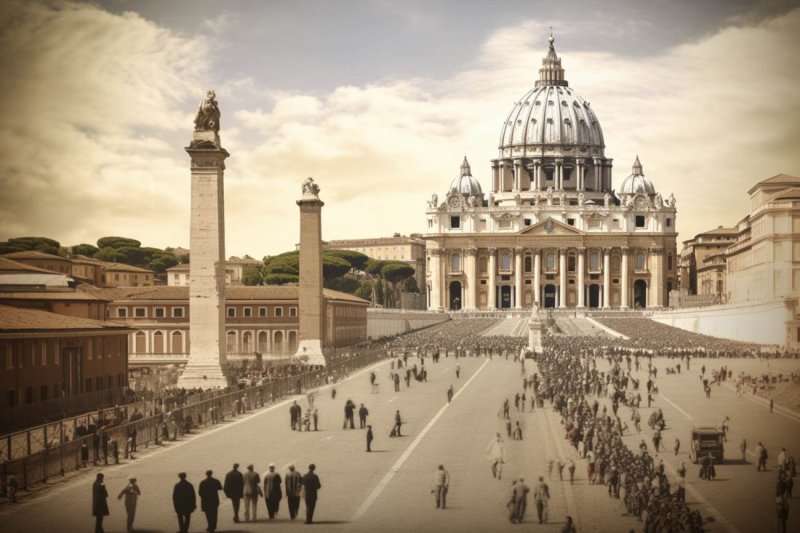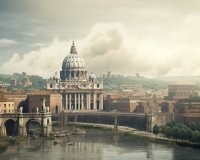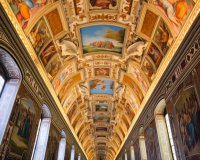Walking Through History: A Timeline of the Vatican’s Evolution

Walking Through History: A Timeline of the Vatican's Evolution
The Vatican, a city-state surrounded by Rome, has a rich and complex history that spans centuries. Let's embark on a journey through time to explore the key milestones in the evolution of the Vatican.
Early Foundations (1st Century AD - 756 AD)
The roots of the Vatican trace back to the 1st century AD when it was established as a burial ground for early Christians. Over time, this sacred site gained prominence, and in 313 AD, Emperor Constantine legalized Christianity, paving the way for the construction of the original St. Peter's Basilica.
Fast forward to 756 AD when the Papal States were established, solidifying the Vatican's political influence. During this period, the Vatican served as the residence of the popes and the focal point of the Catholic Church's authority.
The Renaissance and St. Peter's Basilica (15th - 16th Century)
The Renaissance brought a cultural and artistic revival to Europe, and the Vatican was not exempt from its influence. In the 15th century, Pope Nicholas V commissioned the construction of the Vatican Library, a testament to the Vatican's commitment to intellectual pursuits.
However, the most iconic symbol of the Vatican's Renaissance grandeur is St. Peter's Basilica. Designed by Michelangelo, among others, it stands as a masterpiece of Renaissance architecture and a beacon of the Catholic faith.
The Vatican Museums and Sistine Chapel (16th Century - Present)
One cannot discuss the Vatican's evolution without mentioning its renowned museums. Pope Julius II founded the Vatican Museums in the early 16th century, showcasing a vast collection of art and artifacts, including the world-famous Sistine Chapel ceiling painted by Michelangelo.
Over the centuries, the Vatican Museums have expanded, housing treasures from different periods and cultures. Today, millions of visitors flock to witness the artistic and historical riches within its walls.
The Lateran Treaty and Vatican City (1929)
In 1929, the Lateran Treaty marked a significant turning point in the Vatican's history. This agreement between the Holy See and Italy recognized Vatican City as an independent sovereign state, ensuring the Vatican's autonomy and allowing it to maintain its spiritual and cultural role.
With the establishment of Vatican City, the Vatican became the smallest independent state in the world, solidifying its unique status as both a religious and political entity.
The Second Vatican Council (1962 - 1965)
The mid-20th century brought about a period of introspection and reform within the Catholic Church. The Second Vatican Council, convened by Pope John XXIII, sought to modernize the Church and adapt it to the changing times.
This council led to significant reforms, including changes in liturgy, increased emphasis on ecumenism, and a more open approach to the modern world. The impact of the Second Vatican Council continues to shape the Catholic Church's identity and interactions with the global community.
Conclusion: A Tapestry of Faith, Art, and Diplomacy
As we walk through the history of the Vatican, we witness a tapestry woven with threads of faith, art, and diplomacy. From its humble beginnings as a Christian burial ground to the grandeur of St. Peter's Basilica and the Vatican Museums, the Vatican's evolution reflects the dynamic interplay of religious and cultural forces throughout the ages.
Today, the Vatican stands not only as a spiritual center for millions of Catholics worldwide but also as a symbol of cultural heritage and diplomacy. Its journey through history continues, leaving an indelible mark on the annals of human civilization.
Vatican City: St. Peter's Basilica Digital Audioguide
Experience the rich history and art of the Vatican with a visit to the iconic St. Peter's Basilica. Unravel the stories behind priceless works from the Papal collections.
About this ticket
Free cancellation | Reserve now & pay later | Special Covid-19 precautions in place
Duration:
2 hours | Audio guide available in Spanish, Chinese, English, French, German, Italian
Highlights
• Immerse yourself in the history of St. Peter's Basilica with a mobile audio guide
• Explore treasures inside the basilica at your own pace
• Download an audio guide on your smartphone for maximum flexibility
• See St. Peter’s tomb and the original basilica walls while learning about them
• Journey through art and religion at this iconic landmark
Embark on a captivating 60-minute audio-guided tour on your smartphone, delving into the grandeur and magnificence of St. Peter's Basilica. Commissioned in the 16th century, it stands as a testament to religious significance and architectural brilliance.
Learn about the construction of its towering dome, marvel at the oculus bathing the interior in celestial light, and discover renowned tombs within. The audio tour, with 27 listening points and a digital map, unveils the basilica's intricate details, from ornate decorations to mosaic artwork.
Whether an art enthusiast, history buff, or spiritual seeker, this audio-guided tour offers a comprehensive experience, deepening understanding of the basilica's cultural and religious significance.
Includes
Smartphone audio guide | Self-guided Vatican tour | Headsets | Live guide
Meeting point
No fixed meeting point. Receive a QR code at booking to download the audio guide. Visit the Basilica at your convenience.
Important information
Bring headphones and a charged smartphone. Dress code enforced. Security wait times may be up to 120 minutes during high season. St. Peter’s Basilica may be closed in the morning on Papal Audience days.
From $6.30 per person
Reserve now & pay later to book your spot and pay nothing today. Gift options available.
The Vatican's Humble Beginnings
The Vatican, officially known as the Vatican City State, is a tiny independent city-state enclaved within Rome, Italy. It is not only the spiritual center of the Catholic Church but also one of the most historically and culturally significant places in the world. The Vatican's rich history has humble beginnings that date back to ancient times.
The story of the Vatican's origins can be traced to the founding of Rome itself. In the early centuries of the first millennium BC, Rome was a small village on the banks of the Tiber River. It gradually grew into a powerful city that would later become the center of a vast empire. The Vatican's connection to Rome's growth and transformation is deeply intertwined.
Early Roman Influence
During the Roman Republic, the area that is now Vatican City was primarily used for agricultural purposes. It was just one of the many districts in the developing city. However, as Rome expanded, so did its influence, and the Vatican's significance began to emerge.
The turning point in the history of the Vatican occurred in the 1st century AD when Christianity started to spread across the Roman Empire. St. Peter, one of the twelve apostles of Jesus, is traditionally believed to have been martyred in Rome. His tomb, now located beneath St. Peter's Basilica, became a focal point for early Christian pilgrims. This marked the beginning of the Vatican's association with the Christian faith.
The Construction of St. Peter's Basilica
One of the most iconic landmarks in the Vatican, St. Peter's Basilica, played a crucial role in shaping the city-state's identity. The construction of the basilica was initiated during the Renaissance period, in the 16th century, under the guidance of renowned architects like Donato Bramante, Michelangelo, Carlo Maderno, and Gian Lorenzo Bernini. Their work transformed the Vatican's skyline and solidified its place as a center of Christianity.
The grandeur of St. Peter's Basilica not only served as a testament to the Catholic Church's influence but also as a symbol of the Vatican's growth and evolution from its humble beginnings. Today, it stands as one of the world's most magnificent architectural marvels.
The Vatican Becomes an Independent State
For much of its history, the Vatican was subject to the control and authority of various external powers, including the Papal States and Italy. It was not until the Lateran Treaty of 1929 that the Vatican City officially became an independent and sovereign state, with Pope Pius XI as its head of state. This marked a significant step in the Vatican's journey from a small district in Rome to a globally recognized city-state.
Modern Significance
Today, the Vatican is not only a spiritual and religious center but also a place of immense cultural significance. It houses an extensive collection of art and historical treasures in museums, including the famous Sistine Chapel, where Michelangelo's masterpiece, the "Last Judgment," can be found. The Vatican's libraries and archives are repositories of knowledge and history.
Furthermore, the Vatican City serves as the official residence of the Pope, the leader of the Catholic Church, and the headquarters of the Holy See, the administrative and spiritual center of the Roman Catholic Church. It continues to play a pivotal role in matters of faith, diplomacy, and global influence.
In conclusion, the Vatican's humble beginnings as a small district in ancient Rome have evolved into a powerful and influential city-state. Its rich history, marked by the construction of St. Peter's Basilica and the Lateran Treaty, has shaped it into the iconic and revered place it is today. The Vatican's cultural, religious, and historical significance make it a must-visit destination for travelers and pilgrims from around the world.
St. Peter’s Basilica with Dome Climb and Crypt Tour
Explore the grandeur of St. Peter’s Basilica with our guided tour that takes you behind the scenes of this iconic religious monument. Begin your day early in the peaceful ambiance of St Peter’s Square, away from the bustling crowds. Led by a local English-speaking guide, experience the sacred atmosphere as you delve into the heart of Vatican City.
Ascend 231 steps to the top of the dome, where breathtaking panoramic views of Rome await. Marvel at intricate mosaics up close before climbing higher for an unparalleled perspective of the city. Your guide will provide insights into the artistry of Bernini’s baldachin and Michelangelo’s masterpiece, "Pietá." Explore every nook and cranny of the basilica, gaining a deep understanding of its historical and architectural significance.
Cap off your tour with a visit to the papal crypt, allowing you to explore at your own pace. Please note that this tour is conducted exclusively in English, offering a comprehensive experience of St. Peter’s Basilica's wonders.
Highlights:
- Experience the tranquility of St Peter’s Square before the crowds arrive.
- Climb to the top of the dome for unparalleled views of Rome.
- Explore St. Peter's Basilica, admiring Bernini’s baldachin and Michelangelo’s "Pietá."
- Visit the papal crypt at your leisure.
Important Information:
Meet your guide in front of Caffè Leonina, Piazza Citta' Leonina, just outside St. Peter's Square. Look for the "Walks" sign for easy identification. Please carry a valid passport or ID card. For the comfort and respect of all visitors, kindly avoid shorts, short skirts, and sleeveless shirts.
Please be aware that due to COVID-19 restrictions, there might be limited access to the Dome climb and Papal tombs. Any closures or changes in the schedule will be communicated on the day of the tour. Regrettably, this tour is not suitable for guests with mobility impairments, wheelchairs, or strollers.
Customer Reviews:
Rated at an impressive 4.7 out of 5 based on 1152 reviews, our guests have raved about their experience. Massimo, our knowledgeable guide, ensures a delightful and informative tour. Guests recommend the early morning slot to savor the Basilica's beauty before the city awakens. Sara, another passionate guide, adds to the charm of this unforgettable journey.
Book now to embark on a captivating exploration of St. Peter’s Basilica, uncovering its secrets with our expert guides./
Pivotal Moments in Vatican's History
The Vatican, officially known as the Vatican City State, is the spiritual and administrative center of the Roman Catholic Church. With a rich history spanning centuries, it has witnessed numerous pivotal moments that have shaped its role in the world and the course of the Church itself. Let's explore some of these significant events and eras that have marked the Vatican's history.
The Establishment of the Vatican City
The Vatican City, an independent city-state enclaved within Rome, was established as a sovereign entity on February 11, 1929, with the signing of the Lateran Treaty. This treaty resolved the long-standing "Roman Question" and recognized the Vatican's independence, solidifying its place on the global stage.
The Papal States and the Loss of Territory
Before the establishment of the Vatican City, the Papal States, a vast region in Italy, was ruled by the Pope. However, in the 19th century, Italy was unified, and the Papal States were gradually absorbed into the new nation. The Vatican's territory dwindled, leading to the loss of its political and temporal power.
The Second Vatican Council (Vatican II)
Vatican II, convened by Pope John XXIII in 1962, was a groundbreaking event that aimed to address the role of the Church in the modern world. The Council led to significant reforms, including the use of vernacular languages in the liturgy, a more open approach to interfaith dialogue, and a reevaluation of the Church's stance on various social and moral issues.
The Canonization of Popes John XXIII and John Paul II
In recent history, the Vatican witnessed another pivotal moment with the simultaneous canonization of Pope John XXIII and Pope John Paul II on April 27, 2014. This event celebrated the lives and contributions of these two influential popes to the Catholic Church and the world.
The Resignation of Pope Benedict XVI
In February 2013, Pope Benedict XVI made the unprecedented decision to resign from the papacy due to health concerns. His resignation marked the first papal resignation in almost 600 years and set the stage for the election of Pope Francis, who brought a new direction and emphasis on social justice and humility.
The Vatican and Interfaith Dialogue
The Vatican has played a significant role in promoting interfaith dialogue and understanding. Under the leadership of Pope John Paul II, the Church made significant strides in building bridges with other religions, particularly with Judaism and Islam. These efforts have aimed to foster peace and cooperation among different faith communities.
The Vatican and Social Justice
The Vatican's role in advocating for social justice and addressing global issues cannot be understated. The Church has consistently spoken out on matters such as poverty, climate change, and human rights. Pope Francis, in particular, has been a vocal advocate for the poor and marginalized, emphasizing the Church's commitment to alleviating suffering and promoting social equality.
Conclusion
The Vatican's history is replete with pivotal moments that have shaped the Church's role in the world and its approach to contemporary issues. From the establishment of the Vatican City to the transformative Vatican II, and from the canonization of influential popes to the ongoing commitment to interfaith dialogue and social justice, the Vatican remains a central institution in the global landscape.





